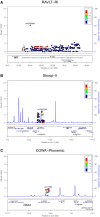Dopamine pathway gene variants may modulate cognitive performance in the DHS - Mind Study
- PMID: 27066308
- PMCID: PMC4797918
- DOI: 10.1002/brb3.446
Dopamine pathway gene variants may modulate cognitive performance in the DHS - Mind Study
Abstract
Background: There is an established association between type 2 diabetes and accelerated cognitive decline. The exact mechanism linking type 2 diabetes and reduced cognitive function is less clear. The monoamine system, which is extensively involved in cognition, can be altered by type 2 diabetes status. Thus, this study hypothesized that sequence variants in genes linked to dopamine metabolism and associated pathways are associated with cognitive function as assessed by the Digit Symbol Substitution Task, the Modified Mini-Mental State Examination, the Stroop Task, the Rey Auditory-Verbal Learning Task, and the Controlled Oral Word Association Task for Phonemic and Semantic Fluency in the Diabetes Heart Study, a type 2 diabetes-enriched familial cohort (n = 893).
Methods: To determine the effects of candidate variants on cognitive performance, genetic association analyses were performed on the well-documented variable number tandem repeat located in the 3' untranslated region of the dopamine transporter, as well as on single-nucleotide polymorphisms covering genes in the dopaminergic pathway, the insulin signaling pathway, and the convergence of both. Next, polymorphisms in loci of interest with strong evidence for involvement in dopamine processing were extracted from genetic datasets available in a subset of the cohort (n = 572) derived from Affymetrix(®) Genome-Wide Human SNP Array 5.0 and 1000 Genomes imputation from this array.
Results: The candidate gene analysis revealed one variant from the DOPA decarboxylase gene, rs10499695, to be associated with poorer performance on a subset of Rey Auditory-Verbal Learning Task measuring retroactive interference (P = 0.001, β = -0.45). Secondary analysis of genome-wide and imputed data uncovered another DOPA decarboxylase variant, rs62445903, also associated with retroactive interference (P = 7.21 × 10(-7), β = 0.3). These data suggest a role for dopaminergic genes, specifically a gene involved in regulation of dopamine synthesis, in cognitive performance in type 2 diabetes.
Keywords: Cognition; DAT1 VNTR; DOPA decarboxylase; dopamine; polymorphism; type 2 diabetes.
Figures

Similar articles
-
Heritability and genetic association analysis of cognition in the Diabetes Heart Study.Neurobiol Aging. 2014 Aug;35(8):1958.e3-1958.e12. doi: 10.1016/j.neurobiolaging.2014.03.005. Epub 2014 Mar 11. Neurobiol Aging. 2014. PMID: 24684796 Free PMC article.
-
Associations between polymorphisms in dopamine neurotransmitter pathway genes and pain response in healthy humans.Pain. 2009 Dec 15;147(1-3):187-93. doi: 10.1016/j.pain.2009.09.001. Epub 2009 Sep 30. Pain. 2009. PMID: 19796878
-
The CADM2 gene is associated with processing speed performance - evidence among elderly with type 2 diabetes.World J Biol Psychiatry. 2019 Sep;20(7):577-583. doi: 10.1080/15622975.2017.1366055. Epub 2017 Oct 5. World J Biol Psychiatry. 2019. PMID: 28797215
-
Role of functional dopaminergic gene polymorphisms in the etiology of idiopathic intellectual disability.Prog Neuropsychopharmacol Biol Psychiatry. 2011 Aug 15;35(7):1714-22. doi: 10.1016/j.pnpbp.2011.05.005. Epub 2011 May 13. Prog Neuropsychopharmacol Biol Psychiatry. 2011. PMID: 21609749
-
Which Dopamine Polymorphisms Are Functional? Systematic Review and Meta-analysis of COMT, DAT, DBH, DDC, DRD1-5, MAOA, MAOB, TH, VMAT1, and VMAT2.Biol Psychiatry. 2019 Oct 15;86(8):608-620. doi: 10.1016/j.biopsych.2019.05.014. Epub 2019 May 28. Biol Psychiatry. 2019. PMID: 31303260
Cited by
-
PheSom: a term frequency-based method for measuring human phenotype similarity on the basis of MeSH vocabulary.Front Genet. 2023 Jul 11;14:1185790. doi: 10.3389/fgene.2023.1185790. eCollection 2023. Front Genet. 2023. PMID: 37496714 Free PMC article.
-
Moderating effect of mode of delivery on the genetics of intelligence: Explorative genome-wide analyses in ALSPAC.Brain Behav. 2018 Dec;8(12):e01144. doi: 10.1002/brb3.1144. Epub 2018 Oct 31. Brain Behav. 2018. PMID: 30378284 Free PMC article.
-
Parkinson disease-associated cognitive impairment.Nat Rev Dis Primers. 2021 Jul 1;7(1):47. doi: 10.1038/s41572-021-00280-3. Nat Rev Dis Primers. 2021. PMID: 34210995 Review.
-
Cardiovascular dysautonomia and cognitive impairment in Parkinson's disease (Review).Med Int (Lond). 2024 Sep 19;4(6):70. doi: 10.3892/mi.2024.194. eCollection 2024 Nov-Dec. Med Int (Lond). 2024. PMID: 39355336 Free PMC article. Review.
-
Pharmacogenomics in type 2 diabetes: oral antidiabetic drugs.Pharmacogenomics J. 2016 Oct;16(5):399-410. doi: 10.1038/tpj.2016.54. Epub 2016 Jul 19. Pharmacogenomics J. 2016. PMID: 27432533 Review.
References
-
- Abbott, G. W. 2014a. Biology of the KCNQ1 potassium channel. New J. Sci. 2014:1–26.
-
- Aliev, G. , Shahida K., Gan S. H., Firoz C., Khan A., Abuzenadah A. M., et al. 2014. Alzheimer disease and type 2 diabetes mellitus: the link to tyrosine hydroxylase and probable nutritional strategies. CNS Neurol. Disord. Drug Targets 13:467–477. - PubMed
Publication types
MeSH terms
Substances
Grants and funding
LinkOut - more resources
Full Text Sources
Other Literature Sources
Medical

